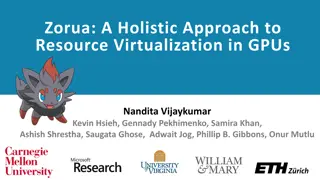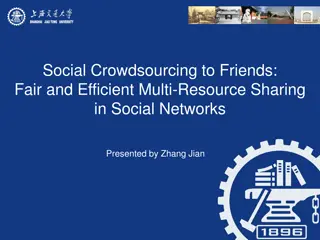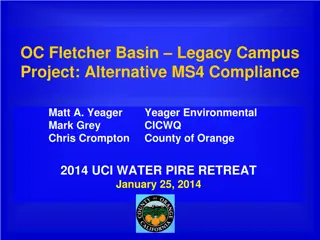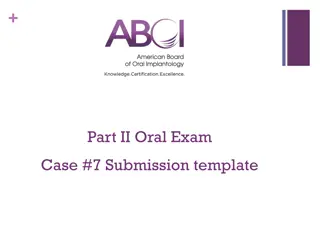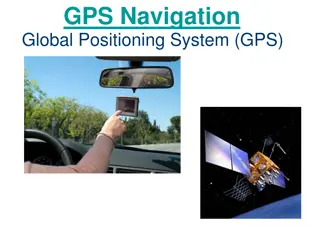
Resource Augmentation and Online Algorithms for Memory Management
Explore the concepts of resource augmentation and online algorithms in the context of memory management. Learn about different paging and scheduling strategies to optimize memory access and minimize page faults. Discover solutions such as the furthest-in-future algorithm and the challenges of using online methods like LRU in real-life scenarios.
Download Presentation

Please find below an Image/Link to download the presentation.
The content on the website is provided AS IS for your information and personal use only. It may not be sold, licensed, or shared on other websites without obtaining consent from the author. If you encounter any issues during the download, it is possible that the publisher has removed the file from their server.
You are allowed to download the files provided on this website for personal or commercial use, subject to the condition that they are used lawfully. All files are the property of their respective owners.
The content on the website is provided AS IS for your information and personal use only. It may not be sold, licensed, or shared on other websites without obtaining consent from the author.
E N D
Presentation Transcript
Resource Augmentation Amit Sandler, original Episode by Tim Roughgarden
Today Online Algorithms! Online (And Offline) Paging How the two relate Different bound on Online Paging Offline ( And Online ) Routing How the two relate Online and offline Scheduling You know the deal
Paging We have a Slow memory with N pages We have a Fast memory with k<<N pages A series of Page requests ? = ? ,? , ,? come over time, and we want to minimize slow memory access We measure an algorithm by how many page faults it makes Less is better. ???? ???,?,? = #???? ??????
Simple Optimal Solution Simple Optimal algorithm can solve it in linear time (With some assumptions)
Problem In real life, we don t have access to the whole memory request stream Need to use an online method, such as LRU Least Recently Used
Comparison Competitive Ratio Ratio of performance of an online to an offline algorithm in the worst case on all inputs - ???? ???? ???,?,? ???? ???,?,? In our specific example the ratio was 2
Comparing our Algorithms The competitive ratio of LRU is k Lower bound for the ratio If cache size is k, a stream of 1,2,3,...k,k+1,1,... causes every read to fault on LRU but FIF just trashes k+1 accesses (Actually wrong, but its still the right example Pictures show wrong behevior) We will see:
Very bad We wish to compare FIF and LRU in a way that doesn t make LRU, a good algorithm in practice, so bad Many non practical algorithms have identical bounds Need to use Resource Augmentation
Resource Augmentation Can t compare FIF to LRU But what if we weaken FIF in some way to make it comparable?
Theorem Theorem (Sleator and Tarjan 1985) ???? ???,? + ?,? ? + ? ? + 1???? ???,?,? + ? + ? Notably, for ? = ?, we have ???? ???,2 ?,? 2 ???? ???,?,? + 2 ?
Proof of bound Take random sequence, break it into b maximal blocks of k+c distinct pages Bound page faults from above and below
Upper Bound LRU evicts at most k+c pages each block Each page is evicted once from the cache ???? ???,? + ?,? ? ? + ?
Lower Bound In each shifted block, k+c new pages come Only k-1 may have been stored FIF needs to evict c+1 pages per block Last block is of unknown size ? 1 ? + 1 ???? ???,?,?
Putting it all together ???? ???,? + ?,? ? ? + ? ? 1 ? + 1 ???? ???,?,? ? ? + 1 ???? ???,?,? + 1 + ? ???? ???,? + ?,? ? ? + ? ? + ? ? + 1???? ???,?,? + ? + ?
Other Bound Different connection between Offline and Online Algos Theorem (Young, 2002) - For every page request sequence z, and for every ?,? > 0 , we have for a given cache size ? In probability , we know nothing ???? ???,?,? = ? ? ???? ???,?,? ???? ???,?,? ? ? 1 ? log1 Either our cache size is bad, or it s fast compared to FIF, or its just fast.
Proof We will use some positive constant c to be defined later Separate our cache sizes into two, wherever ???? ???,? + ?,? 1 2???? ???,?,? or not
The good Case Our bigger cache doesn t help us much ???? ???,? + ?,? 1 ???? ???,? + ?,? ? + ? 2???? ???,?,? ? + 1???? ???,?,? + ? + ? If yes than we have good cache size and a bound on ???? ???,?,? with ratio 2(?+?) ?+1 and we are done ? log1 ? ???? ???,?,? 1 ???? ???,?,? = ? Need to show our choice of ? satisfies - Later
The Bad Case Adding ? improves us at least twice If our ? is larger than ? ?other bad cache sizes, than we note There s a series of ? + 1 bad sizes ending in k Difference of c between each one Denote series by ? , with ? = ??+1 ???? ???,??+1,? <1 2 ???? ???,??,? < 2 ? ???? ???,?1,? 2 ? ?
Calculations ???? ???,?,? ? ? ???? ???,?,? < 2 ? ? 1 ? after dividing and taking log We want 2 ? ? so we get ? log2 In probability , we know nothing ?? We want ? ? to be ?? at most, so we get ? and we re done 1 ? log2
?? ? = More Calculations 1 ? log2 1 ? log1 ???? ???,?,? = ? ???? ???,?,? ? ???? ???,? + ?,? ? + ? ? + 1???? ???,?,? + ? + ? 2?? log21 + 2? 2 log21 ? 2(? + ?) ? + 1 ? ? = 2 + ?? log21 ?
Selfish Routing Another common online problem is selfish routing Given a DAG graph (V,E), with source s and sink t nodes, with each of its edges having a cost function Cost function might be dependent of how many units of Flow we are passing through it May be thought of as traffic Want to transfer r (Usually 1) units from source to sink Offline Minimize average, ???? ? ? Online If we cannot improve the cost by moving flow from one route to another No person in traffic can change their route
Example 1 t 1 Optimal Flow is flowing half through 1 and half through x Minima of 1 ? + ? Gets us 3 4 Equilibrium is all through x Everyone wants the faster path Gets us 1 Ratio of 4 3 s ?
Example 2 t 1 ? 1 ?+1through ?? and the Optimal Flow is flowing rest through 1 Minima of 1 ? + ??+1 Gets us something that gets to 0 as d goes to infinity Equilibrium is all through ?? Everyone wants the faster path - Gets us 1 Ratio goes to infinity with ? s ??
Example 3 ? 1 Optimal flow Half choose the top path, half bottom, again, by minimizing a function 0 s t Gets us 1.5 1 ? By equilibrium everyone chooses the ? paths Gets us 2, With Ratio of 4 3
Example 4 ? 1 Optimal flow and Equilibrium are equal! Minimizes ? 1 + ? + 1 ? (1 + (1 ?)) Ratio 1! s t 1 ?
Theorem Roughgarden and Tardos(2002) For every network with non negative, continuous, and nondecreasing edge weights, for every traffic rate ? > 0 and every ? > 0 we have NE G,r OPT(G, 1 + r) For ? = 1, we have NE G,r OPT(G,2r) A less busy road network is as busy as a busy road network where you can control all the cars
Proof Parallel edges We note in the equilibrium there s a number, L, such that every edge we took has cost L, and every edge we didn t take has cost at least L Total Cost is ? ?
Calculation ?1 ?|???? ??? ?2 ?|????< ???
Calculation ??? ?,? 1 + ? ??? ???? ??? ? ? ??? ???? ?? = ? ??? ? ? ? ? = ? 1 + ? ? ??? ? 1 + ? ? ?? ? ? ? ? ? 1 + ? ? ? ? ? ?
Proof General Graphs We note in the equilibrium there s a number, L, such that every path we took has cost L, and every pathwe didn t take has cost at least L Total Cost is ? ?
Proof General Graphs Replace cost function by the maximal number generated from the cost and Equilibrium Flow, instead of decomposing ???? ? ??? ???? ? ,???? (?? ) Lower bound of real optimum with fake functions is ? 1 + ? ? Why? Shortest path is L Explicitly slowed down with Ghost Cars
How much did we slow down OPT? Let s look at every edge For edges E where we routed more than the equilibrium flow, this is 0 ? E ,???? ??? = ???? ??? , ???? ? = ??? ???? ? ,????(?? ) ??? ???? (??? ) ? ? = ??? ???? ??? ? ?
How much did we slow down? For roads E where we didn t go over the equilibrium flow, its bounded by the equilibrium flow, from monotonicity e E ,??? ???? ??? ??? ???? ?? e E ,??? ???? ??? ??? ???? ??? ??? ???? ?? ?? ???? (?? ) ??? ???? ??? ?? ???? ?? ??? ???? (??? ) ? ? ? ?













